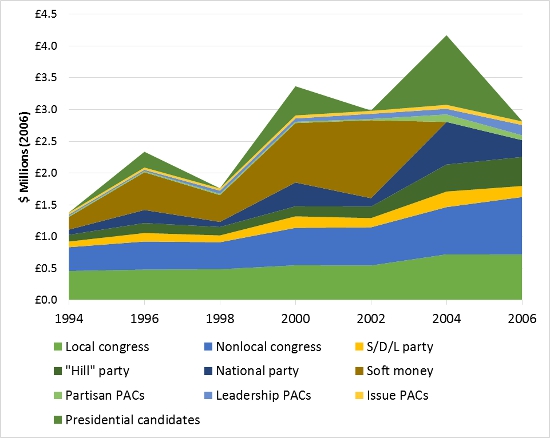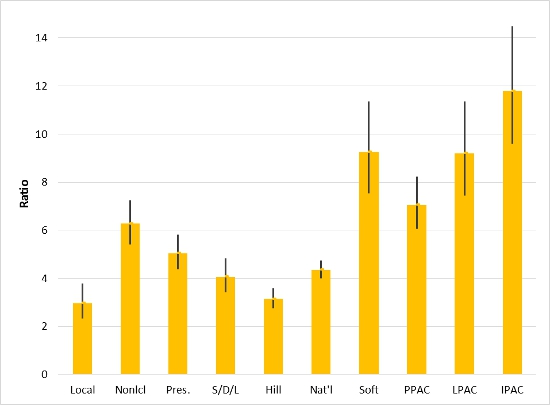 Recent election cycles in the U.S. have seen a massive increase in fundraising by political campaign committees. In new research, Robert C. Lowry finds that these committees do not all raise money from the same kinds of communities. Studying itemized contributions by individuals to campaign committees, he writes that competitive districts generate more contributions to local candidates running in those districts, but there are fewer predicted contributions to many other kinds of committee. He also finds that the contributions made can be greatly affected by the district’s levels of income, education and urbanization.
Recent election cycles in the U.S. have seen a massive increase in fundraising by political campaign committees. In new research, Robert C. Lowry finds that these committees do not all raise money from the same kinds of communities. Studying itemized contributions by individuals to campaign committees, he writes that competitive districts generate more contributions to local candidates running in those districts, but there are fewer predicted contributions to many other kinds of committee. He also finds that the contributions made can be greatly affected by the district’s levels of income, education and urbanization.
Most political campaign committees that are regulated by the U.S. Federal Election Commission (FEC) have the same rules for fundraising save for some differences in maximum contribution limits. However, they do not all raise their money from the same kinds of communities. Whereas all committees tend to rely on areas with richer and more highly educated residents, the degree to which they do so varies widely. Committees that solicit funds nationally also raise more money from urban areas than rural areas even after controlling for differences in income and education, and gain more money from congressional districts that are not politically competitive than those that are.
Comparing contributions to different kinds of committees is difficult using the traditional approach to studying campaign contributions, which relies on surveys of individuals. While these surveys have yielded many important findings, their limited sample size means that the number of donors to any particular kind of committee is far too small for systematic analysis.
Another way to study contributions is to use data on itemized contributions (those of more than $200) by individuals to committees regulated by the FEC. These can be combined with census data to determine the total amount of money raised by different types of committees from geographic areas which have certain characteristics. Committee types include those that support candidates for Congress or the presidency, political party committees, and political action committees not sponsored by a corporation, labor union or trade association. (PACs sponsored by another organization can only solicit contributions from individuals affiliated with that organization.) A further distinction exists between contributions to congressional candidates from donors in their district or state (“local” contributions), and those from donors who would not be directly represented by the candidate.
Figure 1 shows the average contributions in constant dollars per congressional district for the 1994 through 2006 election cycles. “S/D/L party” indicates contributions to state, local or district party committees, while “Hill” committees are the House and Senate campaign committees. The Bipartisan Campaign Reform Act (McCain-Feingold) eliminated “soft” money contributions – unlimited contributions made to support party building activities by political parties – beginning in 2004. Most of the slack was made up by increased hard money contributions to national and Hill party committees, but also by contributions to congressional candidates running outside the donor’s district or state. In fact, starting in 2000 these “nonlocal” donors accounted for more than half of all itemized contributions by individuals to congressional candidates. Contributions to PACs aligned with a political party or run by politicians (leadership PACs) also grew rapidly, but they remain a small part of the whole.
Figure 1 – Itemized Contributions per Congressional District

Figure 2 shows the effects of local electoral competition on predicted contributions from individual districts. Column heights are the ratio of predicted contributions from a district with an open seat race for House of Representatives, a contested race for U.S. Senate, and close voting in the last presidential race to a district with a contested House race, no Senate race, and relatively one-sided voting for president. The vertical lines represent 95 percent confidence intervals for these ratios. The predicted ratio for presidential committees is for presidential election year cycles only.
Figure 2 – Effect of Competitive Congressional Races on predicted contributions from districts

Competitive districts generate many more contributions to congressional candidates running in those districts (of course), but fewer predicted contributions to every other kind of committee save state, district or local political parties. The effect is statistically significant for contributions to nonlocal congressional candidates, leadership PACs organized by politicians, and issue PACs that support a particular cause such as civil rights, lower taxes, or environmental protection.
It is well known that people with more income and education are more likely to make political contributions, and research also implies that people in more densely populated areas are more likely to contribute due to fundraising networks and possible contagion effects. But how important are these variables for different kinds of committees?
Figure 3 shows the ratios of predicted contributions from a district that has high or low per capita income, education attainment, and urbanization prior to the elimination of soft money in 2004. Contributions to local congressional candidates are the least affected, but even then a district that scores high on all three measures is predicted to generate three times as much money as a district that scores low on all three. The ratio is three to four for hard money contributions to party committees; about five for contributions to presidential candidates; six for contributions to congressional candidates from outside the district or state; and seven to twelve for soft money and contributions to various kinds of PACs. Following the elimination of soft money, the ratios for the national and Hill party committees increased slightly, while those for all three types of PACs decreased slightly.
Figure 3 – Effect of Income, Education and Urbanization, 1994-2002

One limitation of this research is that it only includes contributions by donors who give more than $200 during an election cycle. For some committees, contributions from “small” donors make up a majority of the total. It is not likely that these smaller contributions vary as much with income, education, and perhaps urbanization or political competition as larger contributions, but we really don’t know.
Of course, the campaign finance world has changed rapidly in recent years as a result of U.S. Supreme Court decisions and innovation. Many of the new channels (such as the recently rise of ‘dark money’) for fundraising by “independent” organizations are not subject to the FEC’s regulations on disclosure. Except for a few mega donors, however, contributions to so-called Super PACs probably look most like soft money contributions before McCain-Feingold.
The fact that total itemized contributions were barely affected by the elimination of soft money illustrates the fact that political fundraisers are flexible and will always react to a change in the rules. While it may not always be very clear exactly how the fundraisers will react, policymakers can try to construct rules that will channel contributions through those channels that raise the fewest problems for representative democracy.
This article is based on the paper, “Analyzing Campaign Contributions in Context: The Effects of Political Environment and Legal Regulations on Itemized Contributions to Federal Campaign Committees,” in American Politics Research.
Featured image credit: Truthout.org (CC-BY-NC-SA-2.0)
Please read our comments policy before commenting.
Note: This article gives the views of the author, and not the position of USApp– American Politics and Policy, nor of the London School of Economics.
Shortened URL for this post: http://bit.ly/1LyPKVN
_________________________________
 Robert Lowry – University of Texas at Dallas
Robert Lowry – University of Texas at Dallas
Robert Lowry is Professor of Political Science at the University of Texas at Dallas. His research interests include political and civic organizations, fiscal policy and budgeting institutions, and the political economy of higher education.



